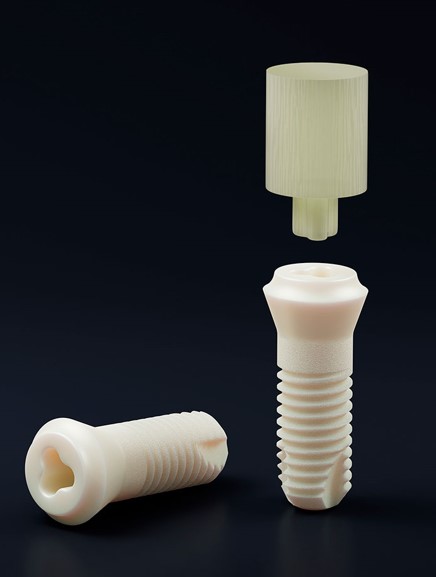
Prospective Study
52 two-piece ZV3 (Patent™) implants for single-tooth replacements over 9 years
Internal sinus lifts and simultaneous grafting of buccal dehiscences were performed when necessary. The study found that long-term successful, reliable and esthetic restorations can be achieved with two-piece Patent™ Implants.
- 94.1% survival rate
- 1 implant lost after 110 months
- No implant fractures
- PI, BOP and PD scores unchanged between the 2- and 9-year follow-up
- Mean BOP score of 12.9%
- No BOP in 55.2% of patients
- BOP in 50% of sites in only two patients
- Mean PD of 3 mm
- Stable tissue levels after 9 years (gingival recession of < 1 mm for all implants)
Prospective Study
52 two-piece ZV3 (Patent™) implants for single-tooth replacements over 9 years
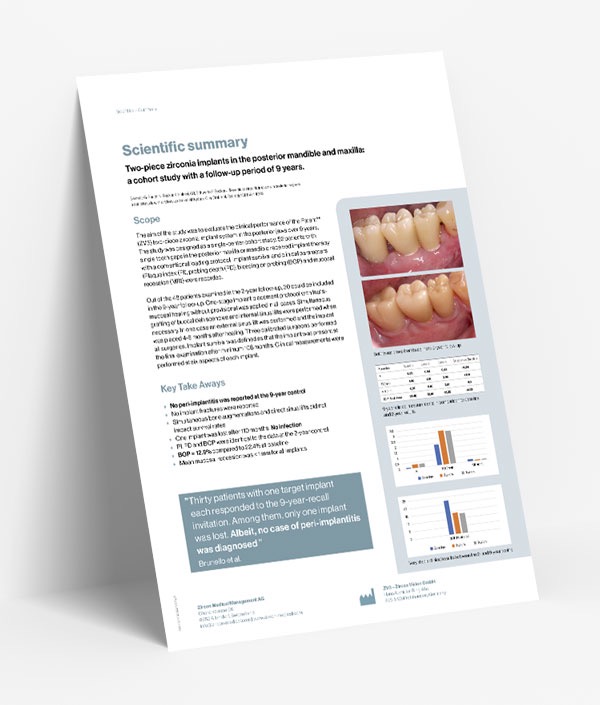
Internal sinus lifts and simultaneous grafting of buccal dehiscences were performed when necessary. The study found that long-term successful, reliable and esthetic restorations can be achieved with two-piece Patent™ Implants.
- 94.1% survival rate
- 1 implant lost after 110 months
- No implant fractures
- PI, BOP and PD scores unchanged between the 2- and 9-year follow-up
- Mean BOP score of 12.9%
- No BOP in 55.2% of patients
- BOP in 50% of sites in only two patients
- Mean PD of 3 mm
- Stable tissue levels after 9 years (gingival recession of < 1 mm for all implants)
Prospective Study
52 two-piece ZV3 (Patent™) implants for single-tooth replacements over 2 years
Internal sinus lifts and simultaneous grafting of buccal dehiscences were performed when necessary. This study concluded that two-piece Patent™ Implants can be successfully used in the clinical indication investigated.
- 95.8% survival rate
- Implant failure was significantly correlated
to the oral surgeon who placed the implant - No implant fractures
- All implant sites showed an increase in the vestibular gingival level
and a gain of keratinized tissue at 24 months
Prospective Study
52 two-piece ZV3 (Patent™) implants for single-tooth replacements over 2 years
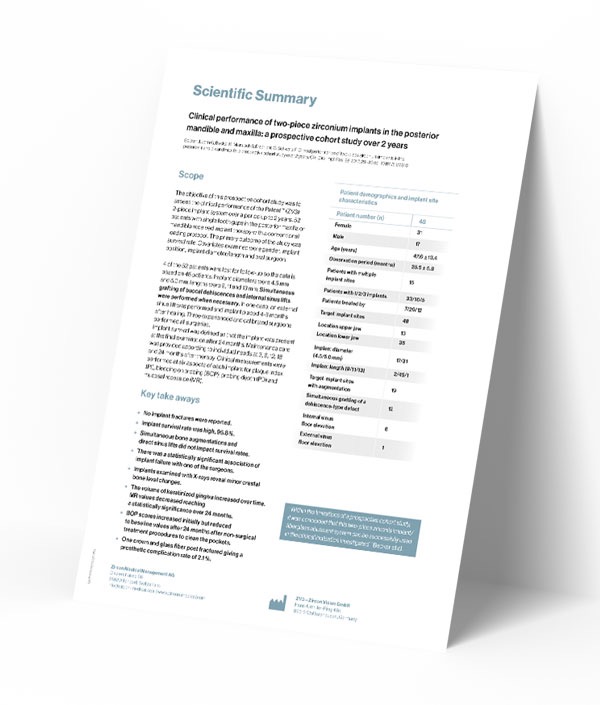
Internal sinus lifts and simultaneous grafting of buccal dehiscences were performed when necessary. This study concluded that two-piece Patent™ Implants can be successfully used in the clinical indication investigated.
- 95,8% survival rate
- Implant failure was significantly correlated to the oral surgeon who placed the implant
- No implant fractures
- All implant sites showed an increase in the vestibular gingival level and a gain of keratinized tissue at 24 months

Retrospective Study
91 Patent™ Implants in 39 patients over 5 to 12 years of function
The implants were placed immediately or delayed and loaded immediately, or loading was delayed. Bone grafting was performed when necessary. The study reported that Patent™ Implants can be used in compromised patients (systemic disease, heavy smokers, periodontitis, medication), regardless of placement or loading protocol, with little biological complication over the long term.
- No peri-implantitis according to current definitions (Berglundh et al.)
- No progressive bone loss
- 8 implants showed bone loss of 3 mm as a consequence of implant placement too deep
- 3 implants showed peri-implant mucositis, but there were no pockets around the other implants
Retrospective Study
91 Patent™ Implants in 39 patients over 5 to 12 years of function
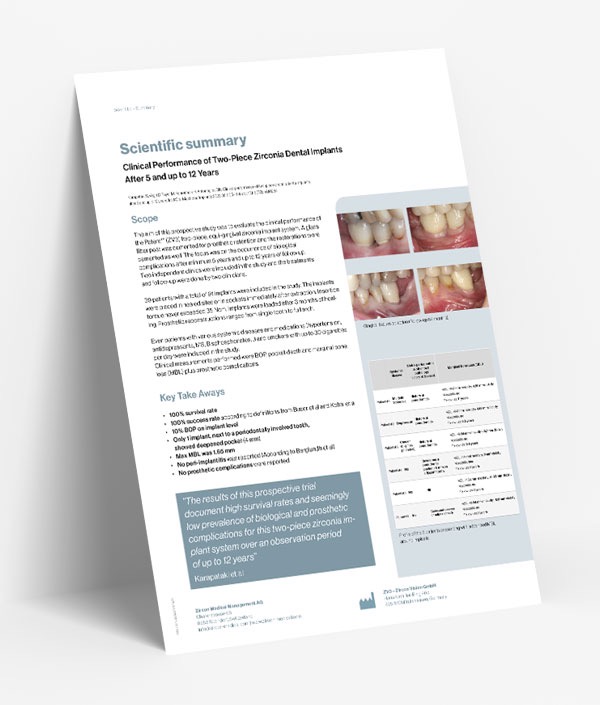
The implants were placed immediately or delayed and loaded immediately, or loading was delayed. Bone grafting was performed when necessary. The study reported that Patent™ Implants can be used in compromised patients (systemic disease, heavy smokers, periodontitis, medication), regardless of placement or loading protocol, with little biological complication over the long term.
- No peri-implantitis according to current definitions (Berglundh et al.)
- No progressive bone loss
- 8 implants showed bone loss of 3 mm as a consequence of implant placement too deep
- 3 implants showed peri-implant mucositis, but there were no pockets around the other implants
Retrospective Study
121 ZV3 (Patent™) implants in 74 consecutively treated patients over 3 years
The study concluded that, in partially edentulous patients, Patent™ Implants, whether placed immediately or not, offer three-year survival rates similar to that of titanium implants and achieve healthy and stable soft and hard tissue.
- 96.5% survival rate over 3 years
- Mean PD of 1.8 ± 0.4 mm and mean BOP scores of 4.1% ± 4.2%
- Significantly lower PD and BOP around implants than around teeth
- Stable marginal bone levels (mean bone loss of 0.1 ± 0.6 mm after 3 years)
Retrospective Study
121 ZV3 (Patent™) implants in 74 consecutively treated patients over 3 years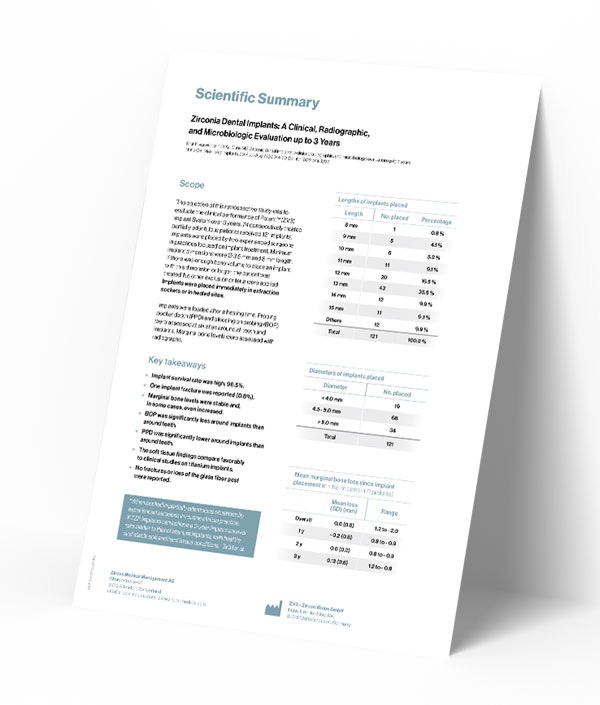
The study concluded that, in partially edentulous patients, Patent™ Implants, whether placed immediately or not, offer three-year survival rates similar to that of titanium implants and achieve healthy and stable soft and hard tissue.
- 96.5% survival rate over 3 years
- Mean PD of 1.8 ± 0.4 mm and mean BOP scores of 4.1% ± 4.2%
- Significantly lower PD and BOP around implants than around teeth
- Stable marginal bone levels (mean bone loss of 0.1 ± 0.6 mm after 3 years)
Preclinical Study
in the miniature pig mandible
The study found that Patent™ Implants offer superior osseointegration speed and success and a favorable soft-tissue response similar to that of natural teeth.
-
Bone–implant contact (BIC) of over 70% after 4 weeks of healing (over 80% after 8 weeks of healing)
- Very rough implant surface contributes to rapid bone formation and osseointegration
- Despite nonexistent oral hygiene, only one implant showed slight signs of inflammation
- Beneficial and firm soft-tissue adaptation around the implants
- Soft-tissue seal remained consistently above soft-tissue level after four weeks of healing
Preclinical Study
in the miniature pig mandible
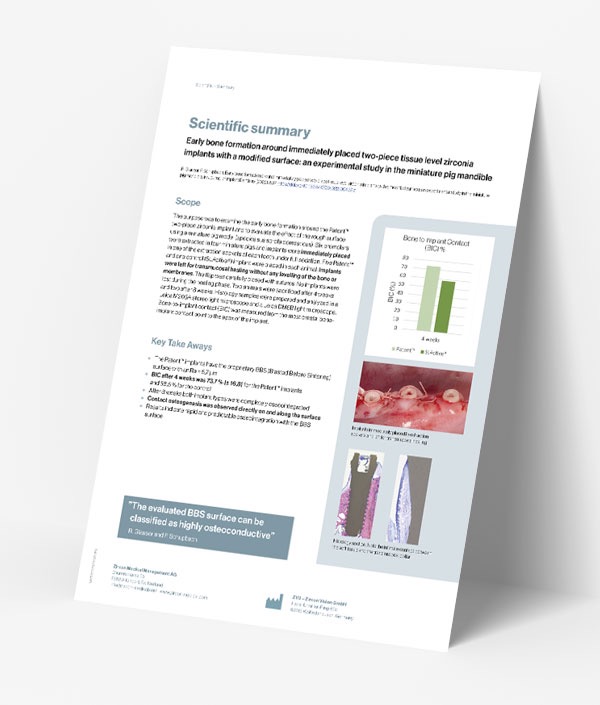
The study found that Patent™ Implants offer superior osseointegration speed and success and a favorable soft-tissue response similar to that of natural teeth.
- Bone–implant contact (BIC) of over 70% after 4 weeks of healing (over 80% after 8 weeks of healing)
- Very rough implant surface contributes to rapid bone formation and osseointegration
- Despite nonexistent oral hygiene, only one implant showed slight signs of inflammation
- Beneficial and firm soft-tissue adaptation around the implants
- Soft-tissue seal remained consistently above soft-tissue level after four weeks of healing

Finite Element Analysis
of Patent™ Implants
The analysis reported excellent results for the Patent™ Implants in the simulation of the effects of stress on the implant and surrounding bone. There was no risk of fracture of the glass fiber post, of the connection between the implant and post, or of the implant.
-
Significantly lower compressive stress on the cortical bone when the implant collar was positioned above it
- A higher positioning resulted in the occlusal load being distributed uniformly throughout the cancellous bone
- Deep placement resulted in high compressive loads on the cortical bone and low stress distribution in the cancellous bone
- Placement too deep should be avoided, as the masticatory forces would generate stress on the bone
Finite Element Analysis
of Patent™ Implants
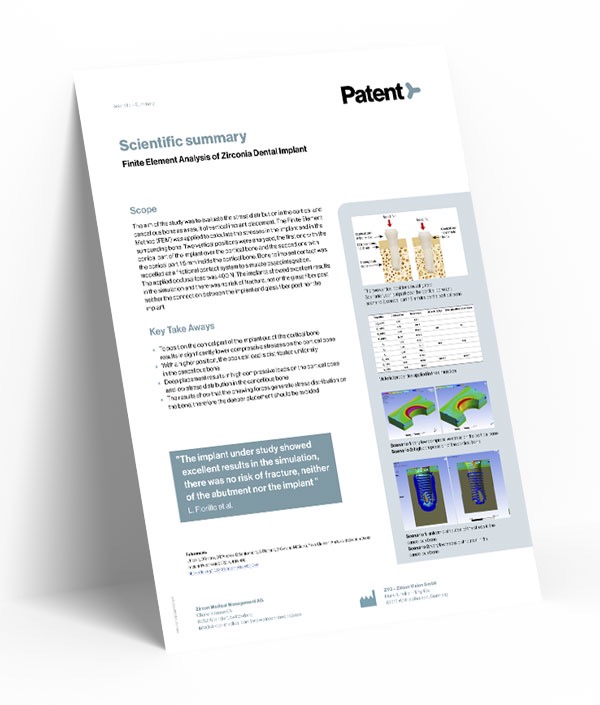
The analysis reported excellent results for the Patent™ Implants in the simulation of the effects of stress on the implant and surrounding bone. There was no risk of fracture of the glass fiber post, of the connection between the implant and post, or of the implant.
- Significantly lower compressive stress on the cortical bone when the implant collar was positioned above it
- A higher positioning resulted in the occlusal load being distributed uniformly throughout the cancellous bone
- Deep placement resulted in high compressive loads on the cortical bone and low stress distribution in the cancellous bone
- Placement too deep should be avoided, as the masticatory forces would generate stress on the bone
First Long-Term Study on Two-Piece Zirconia Implants
Download the Scientific Summary & the Patent™ Intro Guide!
First Long-Term Study
on Two-Piece Zirconia Implants

Download the Scientific Summary & the Patent™ Intro Guide!






